Static reports and rearview analytics are things of the past. By 2025, predictive analytics will not only inform decision-making but also drive autonomous systems, real-time reactions, and hyper-personalized experience delivery. With upcoming predictive analytics trends, ranging from quantum-enhanced forecasting to explainable models powered by AI and Machine Learning in predictive analytics, businesses are now debating how quickly to scale these technologies across teams, systems, and strategies.
The momentum is global and undeniable. Machine learning has led the continent, with North America at 24.73 billion, and Asia leading at $28.39 billion. Africa, on the other hand, lies behind at $1.38 billion, down $27.01 billion from Asia. (Statista)
As technologies like AutoML, digital twins, and graph AI mature, the way organisations handle data is shifting, from dashboard-driven insights to self-optimizing workflows that learn, adapt, and prescribe actions in real time.
In this blog, we explore the top predictive analytics trends shaping 2025 and beyond, and how these innovations are changing the game for industries like eCommerce, fintech, healthcare, travel, and logistics.
Let’s get into what’s next. Starting with one of the most exciting shifts in predictive intelligence.
What’s Next for Predictive Analytics Trends 2025 and Beyond
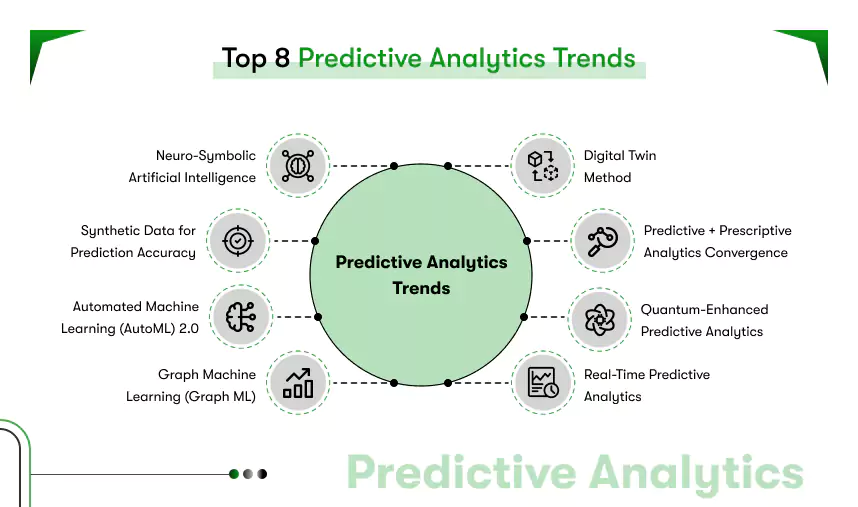
The future of predictive analytics isn’t just about building better models; it’s about creating accessible, intelligent, and ethical systems that help businesses adapt instantly and make smarter decisions at scale. If you want to thoroughly understand how predictive analytics works? You can check our detailed guide.
From AI, you can explain predictions, and you can act on them in milliseconds; predictive analytics is evolving into a strategic driver for every industry. Check out our guide for industry-specific predictive analytics use cases to explore where and how this innovation is happening.
Here’s a list of Top Predictive Analytics Trends 2025.
Trend 1: Real-Time Predictive Analytics
What Is It?
Real-time predictive analytics processes data and generates insights that trigger decisions instantaneously, as and when any event occurs. This is quite in contrast to traditional analytics, which are based on historical data and batch processing: a real-time approach enables businesses to act in the moment, not thereafter.
Why It Matters?
Every split second counts in the modern fast-moving digital economy. Customers expect instantaneous responses, systems need to adapt in real time, and delays may mean lost opportunities, or worse, damage to reputation. Today, real-time analytics is used by organisations as a critical capability, from preventing fraud before its occurrence to rerouting boxes that are in transit.
How Does It Work?
Real-time predictive analytics combines several technologies:
- Streaming data platforms (like Apache Kafka or AWS Kinesis) collect and process data continuously.
- In-memory computing allows for ultra-fast analysis without writing to disk.
- Event-driven architectures trigger actions based on patterns or anomalies the moment they’re detected.
These systems work together to ensure that data doesn’t just inform decisions later, it drives them immediately.
Real-World Example
Using real-time predictive analytics, Uber Eats calculates estimated delivery time, optimises routes for drivers, and reroutes orders when delays occur. These provide the basis for a reactive system in real-time to traffic data, dynamic weather, run time in a restaurant location, and actual driver locations, to keep deliveries fast and accurate.
Benefits
- Instant decision based on real-time data.
- Operations become fast and adaptable.
- Customer satisfaction through good response time.
- Reduced fraud, outages, or delays.
- Improve resource utilisation through systems optimisation in real-time.
In future, if considering predictive analytics vs traditional analytics, real-time predictive analytics trends will become the norm for customer-facing, operational, and mission-critical systems. The companies that would adopt this shift will be able to serve smarter while unleashing a new agility across their entire business, right from supply chain to marketing, customer service, and risk management.
Trend 2: Neuro-Symbolic AI
What is it?
Neuro-symbolic AI is an amalgam of two models: neural networks (deep learning) for pattern recognition, and symbolic reasoning (logic-based rules) for knowledge representation and decision-making.
While traditional deep learning models can detect patterns in unstructured data, they often lack reasoning ability and explainability. Neuro-symbolic AI bridges this gap by enabling AI systems to both learn from data and reason over it, more like humans do.
Why It Matters?
Businesses will increasingly demand transparent, context-aware, and explainable AI systems. As black-box models face regulatory scrutiny and user mistrust, neuro-symbolic AI emerges as a solution that:
- Makes AI interpretable and trustworthy,
- Enables complex, logic-driven decision-making,
- Performs better with less data than deep learning alone.
It will be key in fields like law, healthcare, finance, and enterprise automation, where rule-based reasoning still plays a major role.
How does it work?
Neuro-symbolic AI integrates both neural and symbolic ways of thinking: neural learning processes raw information like text, images, and/or audio; symbolic reasoning applies rules, knowledge graphs, and logic trees.
Imagine a self-driving car: the neural system helps it recognise stop signs, pedestrians, or traffic lights, while the symbolic system applies traffic rules, like stopping the car at red lights or yielding at intersections.
Neuro-symbolic AI-based predictive analytics is a powerful approach that combines perception (neural) and reasoning (symbolic) to generate predictions that are precise, understandable, and aligned with real-world logic. This method reflects the evolving role of AI in Predictive Analytics, where machine learning models not only recognize patterns but also explain their decisions in human-understandable terms.
This gives them the ability to:
- Understand abstract relationships,
- Allow exceptions and contradictions,
- Draw conclusions based on examples and logic.
Example
For legal and compliance use cases, IBM Watson has incorporated neuro-symbolic artificial intelligence. Not only does it read legal documents by means of deep learning, but it also reasons about individual clauses via rule-based frameworks, making decisions much clearer concerning compliance, risk and obligations.
Benefits
- Better interpretation: AI decisions that are easier to audit and justify.
- Efficient learning: Requires less data to perform complex tasks.
- Better generalisation: Handles edge cases and logical reasoning better than pure deep learning.
- Compliance-ready: Transparent logic makes it suitable for regulated industries.
Predictive analytics consulting for Neuro-symbolic AI will strengthen businesses to create intelligent systems that can explain themselves, be compatible with logic, and make more human-like decisions. Predictive analytics innovation trends like neuro-symbolic AI will be particularly valuable where morality, accuracy and accountability are non-negotiable.
Trend 3: Synthetic Data for Prediction Accuracy
What Is It?
Synthetic Data is produced artificially with the intent of mimicking the statistical properties of real-world data and keeping sensitive information safeguarded. This is increasingly being applied for training, testing, and enhancing the performance of models in predictive analysis, especially if the real-world data happens to be scarce, biased, or confidential.
Synthetic data came about to bridge the gaps created by real-world data, which could be scarce, sensitive, or biased. Predictive analytics innovation trends accessing or sharing real data in regulated industries, such as healthcare and finance, are often governed by privacy laws and ethical issues.
Synthetic data can be generated by:
- Generative Adversarial Networks (GANs)
- Variational Autoencoders (VAEs)
- Simulation engines
- Rule-based data synthesis
Why It Matters?
By 2025-26, stricter regulations would be imposed upon industries regarding the usage of data, privacy (GDPR, HIPAA, etc.), and AI fairness. Meanwhile, businesses will require a more diverse and balanced dataset to train efficient predictive models following predictive analytics trends. Having limited data about rare conditions such as Ehlers-Danlos Syndrome (EDS) creates room for misdiagnoses or delays in treatments in healthcare. Recently, AI systems that were trained on common conditions overlook the slightly common symptoms, putting the patients at a higher risk.
Synthetic data addresses these problems by:
- Protecting sensitive information,
- Filling gaps in sparse datasets, and
- Enabling safe model testing under different conditions (e.g., rare events, edge cases).
It will become a strategic asset in industries like finance, healthcare, automotive, and cybersecurity.
How does it work?
Synthetic data is created by learning the structure and distribution of real-world data. It basically generates new records that replicate those patterns but do not correspond to any real individual or event.
Advanced generative models like GANs simulate hyper-realistic data, while rule-based synthesis ensures domain-specific accuracy.
The result: High-quality datasets that are safe, balanced, and where bias can be adjusted.
Example
The American Express uses synthetic data to test fraud detection models without exposing sensitive customer data. This enables them:
- To train models on edge cases (eg, rare fraud patterns),
- Stay compliant with the laws,
- Reduce the risk of overfitting for real user behavior.
Benefits
- Improves model accuracy by diversifying training data.
- Fills gaps in underrepresented scenarios (e.g., fraud, system failures, rare diseases).
- Enables privacy-preserving AI, no real identities involved.
- Supports faster prototyping and testing of predictive models.
- Enhances bias correction and fairness in AI.
In the future of predictive analytics, a new emerging tool for AI teams in high-risk, privacy-sensitive environments is Synthetic Data. Companies will be ahead not only in the area of compliance but also in innovation and development of models that are better in accuracy and future readiness.
Trend 4: Automated Machine Learning (AutoML) 2.0
What Is It?
AutoML 2.0 is the next big leap in automation, moving well beyond just selecting models. It now supports the entire predictive modeling workflow, from data preparation to result explanation, making Machine Learning in Predictive Analytics more accessible, efficient, and impactful than ever before.
- Cleaning and preprocessing of data,
- Engineering of features,
- Explainability and monitoring of the models,
- Reporting of bias detection and compliance.
AutoML 2.0 is designed for enterprise-grade deployment, focused on scalability, governance, and low-code/no-code access for business teams.
Why It Matters?
As businesses generate more data but struggle with AI talent shortages, AutoML 2.0 is stepping in to democratize predictive analytics. Our Predictive Analytics Guide breaks down how this shift is making advanced insights accessible to non-technical teams. By 2025–26, companies will demand:
- Faster model development,
- Smarter automation with less human intervention, and
- Enterprise-level control over accuracy, bias, and fairness.
AutoML 2.0 will give them just that. It will empower analysts, domain experts, and even non-technical teams to build and deploy production-ready predictive models, while maintaining accuracy and compliance.
How does it work?
AutoML 2.0 combines smart automation with model governance. It doesn’t just pick the best algorithm; it prepares your data, builds explainable models, checks for bias, and continuously improves performance. They use the following tech to achieve it:
- Meta-learning to select optimal algorithms based on previous similar tasks.
- Automated data wrangling and feature extraction.
- Explainability layers using SHAP, LIME, or similar tools.
- Feedback loops and continuous learning to refine models post-deployment.
- Bias detection modules for ethical AI compliance.
These platforms often integrate with CI/CD pipelines for smooth deployment and monitoring.
Example
Wells Fargo uses AutoML platforms, empowering risk and compliance teams (non-data scientists) to build loan-default-prediction models. AutoML 2.0 automates the following:
- Engineering features from transaction data,
- Fairness testing to ensure that credit scoring is not discriminatory, and
- Monitoring the model for accuracy drift.
Another example is Uber, which built Michelangelo, their internal AutoML tool that enabled cross-departmental teams to deploy real-time predictive models for pricing, fraud, and driver allocation.
Benefits
- Speeds up model development, from weeks to hours.
- Opens AI to non-experts, reducing dependency on data scientists.
- Enhances model explainability and compliance.
- Scale predictive analytics across business functions.
- Supports continuous learning and automated retraining.
In the future of predictive analytics, AutoML 2.0 will become standard in enterprise AI toolkits by 2026, empowering companies to scale predictive analytics faster, safer, and more efficiently. Organisations that integrate predictive analytics innovation trends like AutoML early will achieve greater data maturity, cost-efficiency, and cross-team agility.

Trend 5: Graph Machine Learning (Graph ML)
What Is It?
GraphML refers particularly to a type of machine learning which can be applied to data that has a graph-formed structure, which usually represents entities as nodes and the relationships among those entities as edges.
In contrast to traditional models that treat data as flat tables, Graph ML learns context, connections, and dependencies, holding up high hopes for prediction in a complex network such as that arising from social graphs, fraud rings, supply chains, and recommendation systems.
Why It Matters?
By 2025–26, organisations will increasingly rely on Graph ML to:
- Uncover hidden patterns in highly connected systems,
- Improve predictive accuracy by leveraging relationships,
- Detect non-obvious fraud, influence, and risk pathways,
- Solve problems where relationships are as important as individual attributes.
As it captures relationships, Graph ML delivers more accurate predictions in environments where context is everything.
How does it work?
Graph ML relies on specialised models, such as Graph Neural Networks (GNNs), Graph Convolutional Networks (GCNs), and Graph Attention Networks (GATs).
As a general overview, the models:
- Represent data as graphs consisting of nodes and edges.
- Uses the message-passing mechanism through which the nodes learn from their neighbors.
- Learn embedding that encodes both features and graphs.
- Make predictions at the node, edge or graph level.
Imagine each node in a network ‘talking’ to its neighbors to learn more about its environment. Over time, it builds an understanding not just of itself, but its connections.
Real-World Example
PayPal uses Graph ML to detect fraud by modeling user transactions and relationships as graphs. Instead of flagging transactions in isolation, Graph ML identifies suspicious behavioral patterns across connected accounts, catching complex fraud rings that traditional models miss.
In e-commerce, Amazon enhances its product recommendation engine using Graph ML by analysing relationships between customers, purchases, reviews and browsing behavior to predict what users are likely to buy next.
Benefits
- Captures complex relationships in structured or semi-structured data.
- Enhances predictions for fraud detection, churn, influence, and recommendations.
- Enables a network-aware approach to personalisation in marketing and customer engagement.
- Great for applications relevant to social graphs, logistics, and financial systems.
Predictive analysis with a relationship-driven insight is an emerging trend in which GraphML will have its application in companies dealing with different ecosystems of data, from fraud detection to real-time personalisation.
Trend 6: Digital Twin Method
What Is It?
Digital twin signifies a dynamic digital replica of a physical object, process, or system in real time. Combined with predictive analytics, it evolves into something called a smart twin, able to simulate future behavior, forecast failures, and optimise performance. These, too, demonstrate intelligent-twin behavior in predicting the next occurrence, giving the platform full power to optimise decision-making and improve operational efficiency.
Why It Matters?
By 2025–26, businesses will move from reactive monitoring to predictive, simulation-driven operations. Digital twins with predictive capabilities will:
- Reduce equipment failures and downtime,
- Optimise logistics, energy use, and workflows,
- Simulate “what-if” scenarios safely and cost-effectively.
As IoT adoption scales and edge computing matures, digital twins will be central to smart factories, cities, hospitals, and supply chains.
How does it work?
- It reflects a real-time capture and generates a digital twin from sensor data, historical records, and system specifications.
- Predictive models are underpinned by the twin to simulate and forecast:
- Failures,
- Performance changes,
- Environmental impact, and many more.
- Infeed insights for improving the physical system or giving operators time to respond before events begin.
Technologies involved: IoT Sensors, Edge computing, AI/ML Models, 3D Visualisation and Real-time data streaming.
Real-World Example
Rolls-Royce uses digital twins with predictive intelligence for its aircraft engines. Each engine has a virtual twin that monitors live flight data. Predictive models simulate wear and performance to forecast when maintenance is needed, before breakdowns occur, reducing costs and increasing safety.
In urban infrastructure, Singapore’s Smart Nation initiative uses digital twins of the city to model traffic, predict flood risks, and optimise energy grids in real time.
Benefits
- Predict failures and proactively maintain systems, minimising unplanned downtime.
- Simulate decisions and scenarios before applying them in the real world.
- Improve safety, sustainability, and efficiency in operations.
- Enable physical assets’ remote monitoring and control.
- Deliver cost savings in energy, resource use, and maintenance.
Predictive digital twins will be standard across asset-heavy and complex environments. Businesses that adopt top predictive analytics trends like digital twin will unlock data-driven foresight, rapid testing of decisions, and next-level operational intelligence, bringing them an edge in innovation and resilience.
Trend 7: Predictive + Prescriptive Analytics Convergence
What Is It?
This approach brings together two different data analytics. It is a combination of predictive analytics (what will happen) with prescriptive analytics (what should we do about it) thus forming a seamless intelligent decision-making system. It is the best predictive analytics strategy for non-tech teams.
While predictive analytics forecasts future outcomes based on historical data, prescriptive analytics takes it a step further, using optimisation algorithms, business rules, and simulations to recommend the best possible actions.
The convergence of both allows organisations to move from insight to action, instantly and intelligently.
Why It Matters?
As data maturity grows, businesses need more than predictions, they need automated, explainable, and optimised decisions. By 2025–26, this convergence will be critical to:
- Reduce human decision fatigue,
- Accelerate response times,
- Improve outcomes across supply chain, finance, and operations,
- Drive autonomous decision-making in real-time systems (e.g., logistics, smart cities).
This fusion empowers AI to not just see what’s coming, but to act in advance, efficiently and strategically.
How did it work?
- Predictive models forecast future events (e.g., demand spikes, equipment failures, customer churn).
- Prescriptive algorithms (using optimisation, simulation, or heuristics) recommend actions to:
- Maximise revenue or uptime,
- Minimise cost, risk, or waste,
- Balance multiple KPIs under constraints.
- Maximise revenue or uptime,
- Outputs may include action plans, ranked options, or automated triggers, often visualised in dashboards or fed directly into systems for execution.
Real-World Example
UPS uses a predictive + prescriptive system in its ORION (On-Road Integrated Optimization and Navigation) platform. It predicts delivery delays based on traffic, weather, and package volume, then prescribes optimal delivery routes and schedules, saving millions in fuel and labor annually.
In healthcare, Cleveland Clinic integrates predictive models (e.g., patient deterioration risk) with prescriptive actions (e.g., resource allocation, early interventions) to enhance outcomes and reduce ICU admissions.
Benefits
- Moves analytics from insight to direct business impact.
- Optimises decisions under multiple constraints (e.g., cost, time, sustainability).
- Reduces response time and manual guesswork.
- Powers autonomous operations in logistics, manufacturing, finance, and more.
- Strategic planning and real-time execution enhancement via AI.
The predictive + prescriptive convergence will form the core design of decision intelligence platforms, which will provide the integration of both worlds: agile real-time enterprise, open, fully autonomous workflows, and better decision making, faster, at scale.
Trend 8: Quantum-Enhanced Predictive Analytics
What Is It?
Quantum-enhanced predictive analytics leverages the power of quantum computing to solve complex prediction problems that are too computationally intensive for classical computers.
It enables faster and more accurate forecasts by:
- Processing large, multidimensional datasets,
- Exploring more possibilities simultaneously,
- Tackling optimisation and simulation problems that are computationally exponential in nature.
While still in its early stages, this trend is poised to redefine what’s possible in predictive modeling, especially in finance, pharma, logistics, and climate science.
Why It Matters?
By 2025–26, quantum computing will begin moving from labs to commercial experimentation, offering breakthroughs in:
- High-speed simulations,
- Complex risk modeling,
- Scenario planning and optimisation.
As classical systems hit performance ceilings, quantum-enhanced analytics will provide an edge in industries dealing with combinatorial problems or massive data environments. Early adopters will position themselves at the forefront of next-gen AI innovation.
How does it work?
They do qubits that enable the representation not just 0 or 1 but also both simultaneously and thus process many outcomes at once. In predictive analytics, quantum techniques are used for:
- Quantum machine learning (QML) towards speeding up model training.
- Quantum annealing for solving complex optimisation problems.
- Quantum simulation for modeling systems such as molecular interactions or financial markets.
Companies typically adopt a hybrid approach where most processes are carried out by their usual traditional systems, but the complex predictive analytics challenges are handled by a quantum system.
Real-World Example
Volkswagen has partnered with D-Wave to find solutions toward improving traffic flow in metropolitan areas through quantum algorithms. The companies have shown how quantum-enhanced forecasting could revolutionise urban mobility by predicting congestion patterns and optimising routes in real-time.
In pharmaceuticals, Roche and IBM are exploring quantum models to simulate protein folding and predict drug interactions, compressing processes that would take weeks into hours.
Benefits
- Solves combinatorial problems that classical systems can’t handle efficiently.
- Faster training and optimisation of complex predictive models.
- Improves accuracy in simulations of physical, chemical, or financial systems.
- Enables real-time decision-making in data-heavy, high-risk environments.
- Positions businesses for future-proof AI infrastructure.
In the coming days, quantum-enhanced predictive analytics will move from theory to prototype in real business environments. While widespread adoption may take time, early investment in quantum-readiness will give innovators a first-mover advantage in solving tomorrow’s hardest problems, faster and smarter than ever before.
What Businesses Should Do to Prepare for Predictive Analytics Trends in 2025–2026
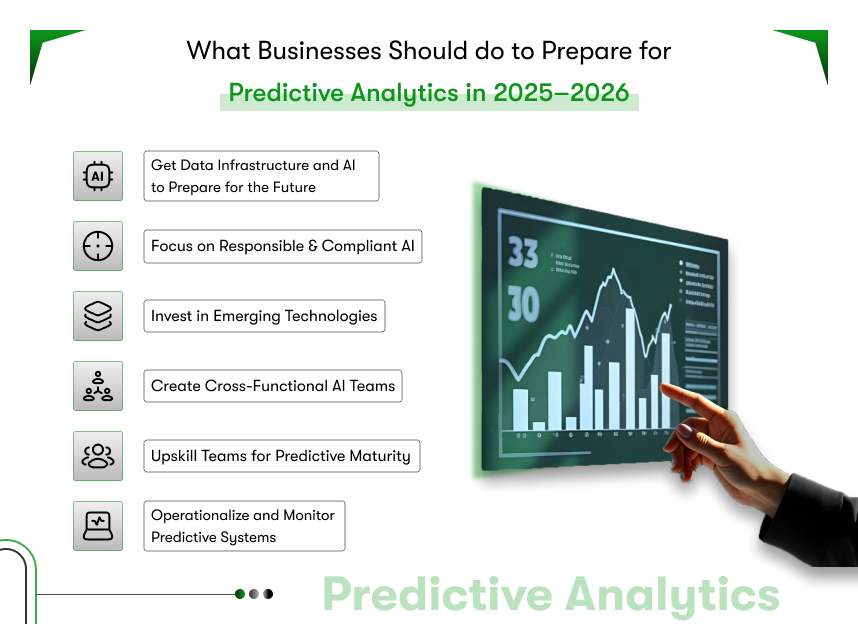
Here’s a list of what businesses should focus on:
1. Get Data Infrastructure and AI To Prepare For the Future
- Revamp your technical stack to reflect a state of real-time processing, multi-modal data capabilities, and edge or quantum.
- The data pipelines must be made clean, secure, and scalable enough for predictive model training and deployment.
2. Focus on Responsible & Compliant AI
- Develop frameworks on ethical AI: fairness audits, explainability, and readiness for the rule.
- They would keep a tab on emerging global laws such as the EU AI Act, the GDPR, and AI accountability mandates.
3. Invest in Emerging Technologies
- Examine and experiment with innovations such as AutoML 2.0, federated learning, graph ML, digital twins, and prescriptive analytics.
- Target lower-risk-higher-value use cases for testing new tools before adoption at a larger scale.
4. Create Cross-Functional AI Teams
- Cross-silo that would vertically capture data scientists, domain experts, compliance officers, and business strategists.
- Cultivate an organization-wide culture of AI collaboration and experimentation by partnering with experts in Predictive Analytics Consulting who can guide teams in applying data-driven insights to real-world challenges.
5. Upskill Teams for Predictive Maturity
- Train technical teams on advanced AI and machine learning, while enabling business teams to make data-driven decisions using predictive tools.
- Develop internal champions who translate data insights into business impact.
6. Operationalize and Monitor Predictive Systems
- Consider treating models in a product manner: versioning, retraining, monitoring, and feedback loops should exist to ensure the model remains relevant and accurate over time.
- Automate maintenance wherever possible to reduce downtime and model drift.
Conclusion: Predictive Analytics Is Evolving – Are You Prepared?
Be it for smarter AI or real-time intelligence, predictive analytics is not merely a support tool; today, it is the strategic core of how modern enterprises do business. Trends shaping 2025 and beyond enable faster decisions, increased accuracy, and a whole lot more agility across industries. The major differentiator, though? Understanding and acting upon the ROI of Predictive Analytics, investing, prioritising on what, and how to scale for long-term impact.
The future is for those who do not just forecast the future but also prepare themselves for its action.

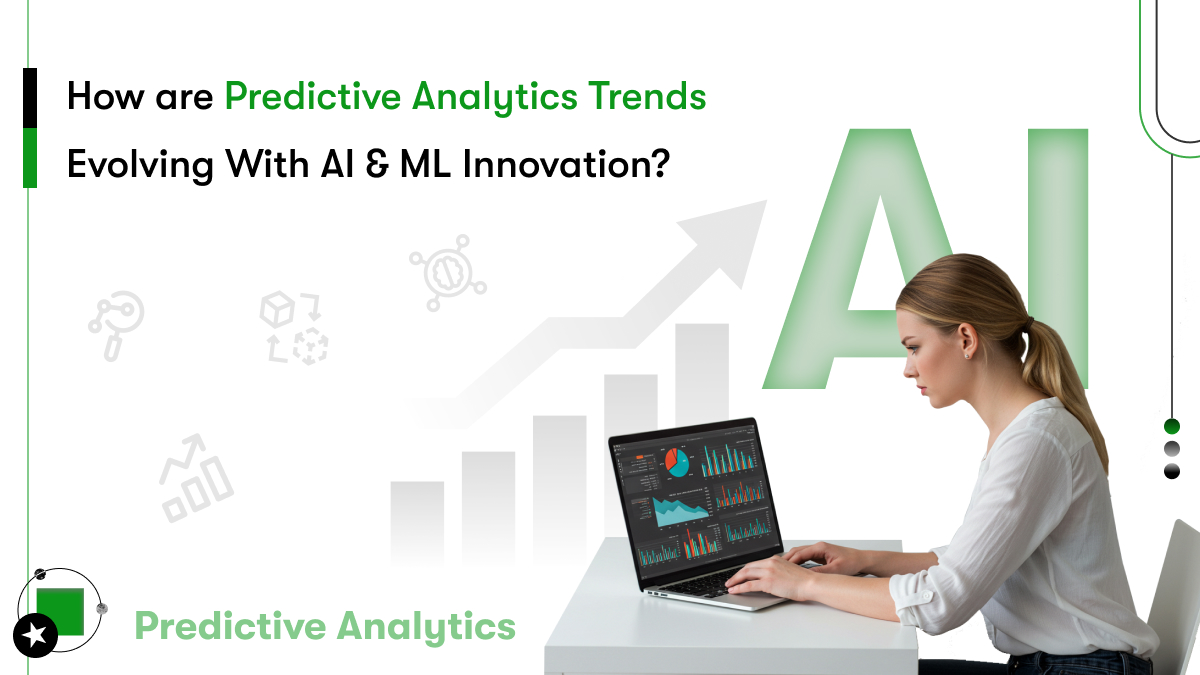
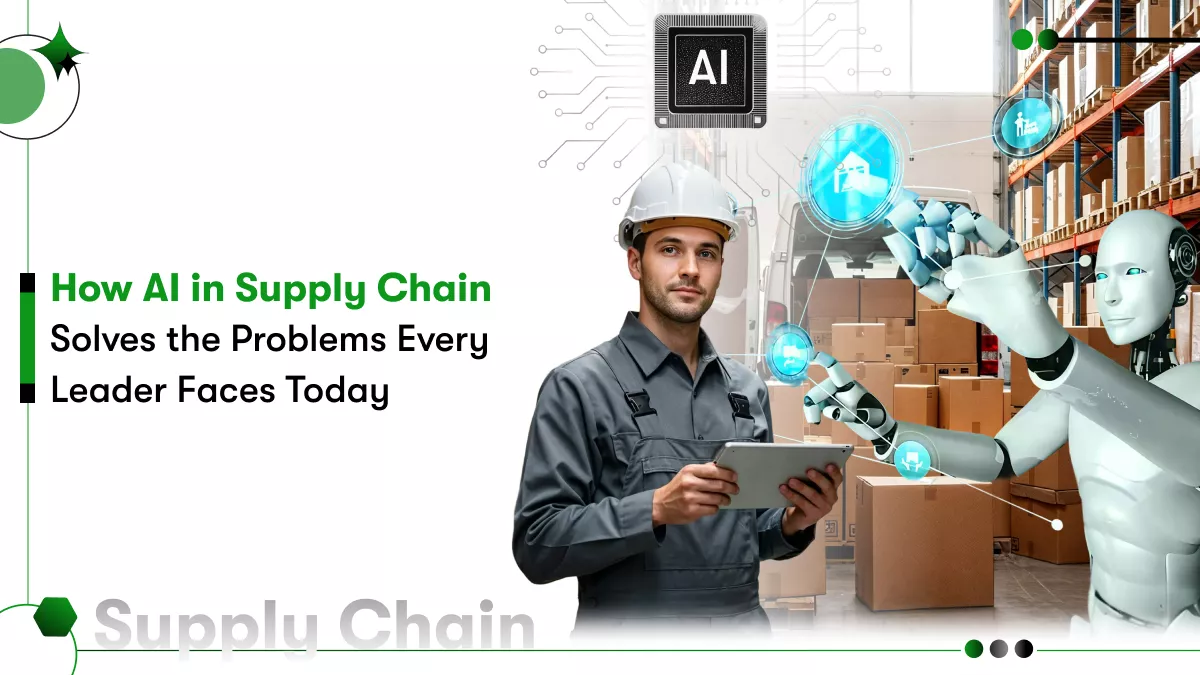
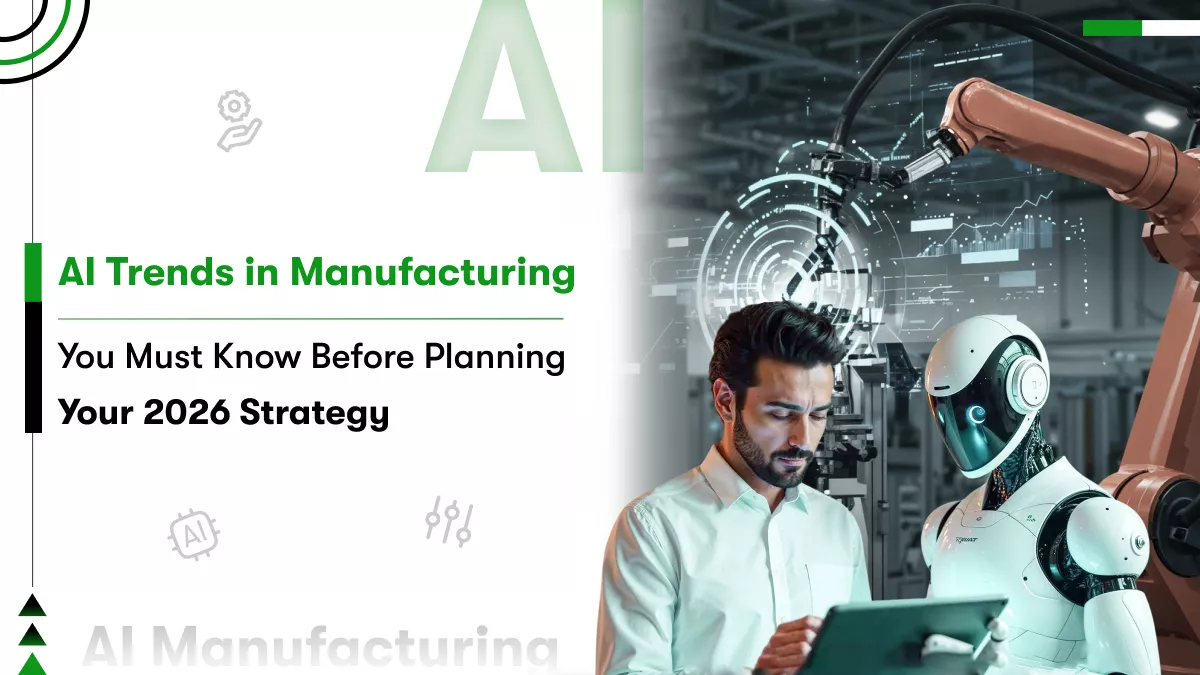
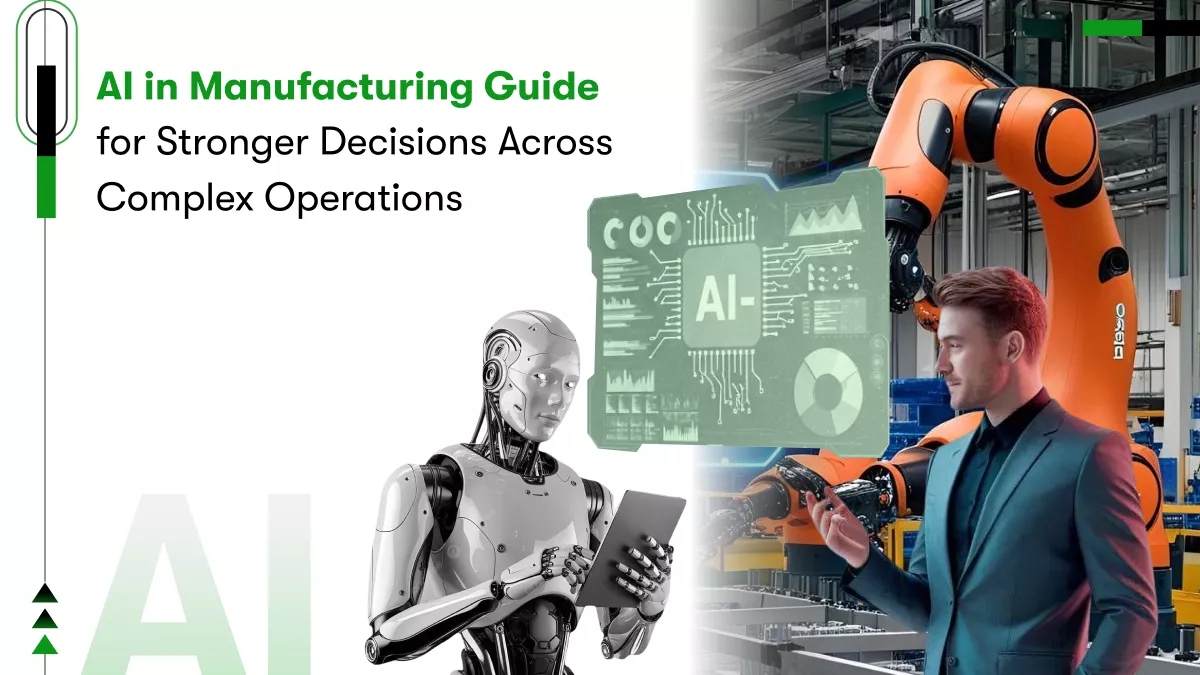
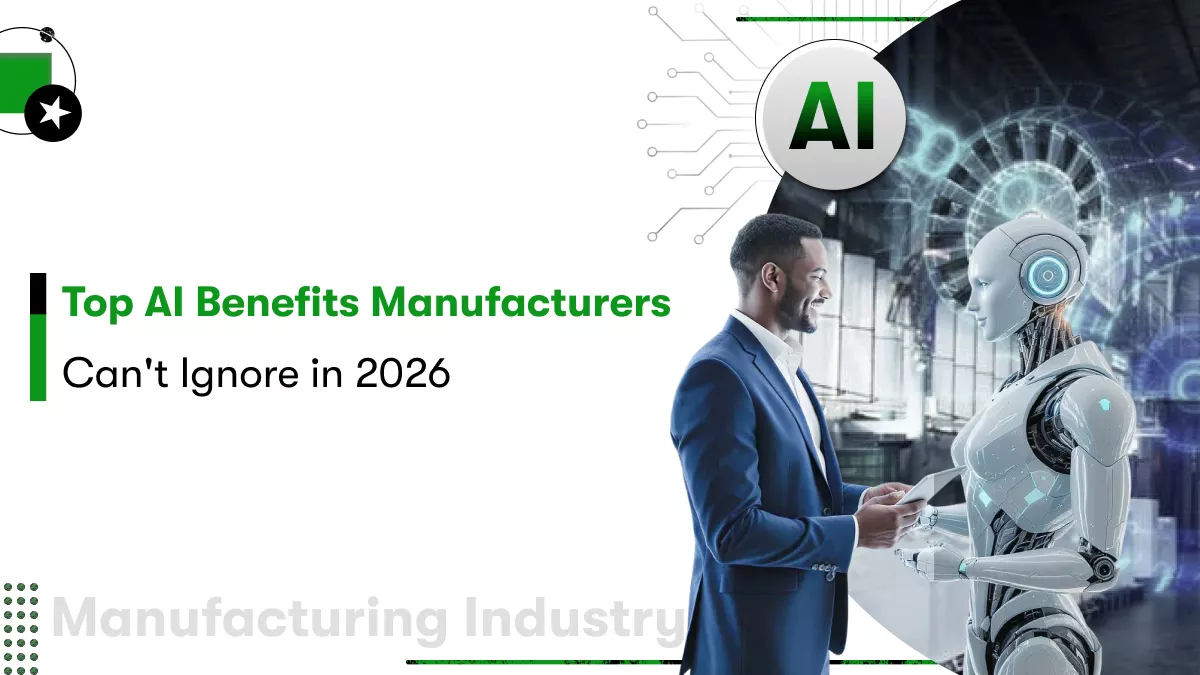







 Contact Information
Contact Information